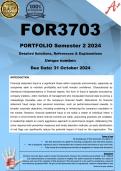FOR3703
PORTFOLIO Semester 2 2024
Detailed Solutions, References & Explanations
Unique number:
Due Date: 31 October 2024
INTRODUCTION
Financial statement fraud is a significant threat within corporate environments, especially as
companies seek to maintain profitability and build investor confidence. Characterized by
intentional misrepresentations in financial reports, this form of fraud is typically executed by
company insiders—often members of management who manipulate financial data to portray a
misleadingly favorable view of the company‟s financial health. Motivations for financial
statement fraud range from personal incentives, such as performance-based rewards, to
broader corporate objectives, including sustaining or enhancing the company‟s reputation in
the market. However, financial statement fraud is not solely a matter of individual intent; it
thrives in environments where internal controls are weak, accounting practices are outdated,
or leadership adopts an overly aggressive approach to performance targets. Addressing this
crime requires both preventive measures and timely detection methods, as early identification
of red flags can significantly reduce the potential impact of fraud on the organization. This
Terms of use
By making use of this document you agree to:
Use this document as a guide for learning, comparison and reference purpose,
Not to duplicate, reproduce and/or misrepresent the contents of this document as your own work,
Fully accept the consequences should you plagiarise or misuse this document.
Disclaimer
Extreme care has been used to create this document, however the contents are provided “as is” without
any representations or warranties, express or implied. The author assumes no liability as a result of
reliance and use of the contents of this document. This document is to be used for comparison, research
and reference purposes ONLY. No part of this document may be reproduced, resold or transmitted in any
form or by any means.
, +27 67 171 1739
INTRODUCTION
Financial statement fraud is a significant threat within corporate environments,
especially as companies seek to maintain profitability and build investor confidence.
Characterized by intentional misrepresentations in financial reports, this form of fraud
is typically executed by company insiders—often members of management who
manipulate financial data to portray a misleadingly favorable view of the company‟s
financial health. Motivations for financial statement fraud range from personal
incentives, such as performance-based rewards, to broader corporate objectives,
including sustaining or enhancing the company‟s reputation in the market. However,
financial statement fraud is not solely a matter of individual intent; it thrives in
environments where internal controls are weak, accounting practices are outdated,
or leadership adopts an overly aggressive approach to performance targets.
Addressing this crime requires both preventive measures and timely detection
methods, as early identification of red flags can significantly reduce the potential
impact of fraud on the organization. This essay will explore the types of financial
statement fraud, reasons for its occurrence, red flags that suggest fraudulent activity,
and effective strategies for its detection and prevention, drawing on the details
provided in the case study to illustrate these critical points.
FINANCIAL STATEMENT FRAUD: AN ANALYSIS
Financial statement fraud is a significant issue in both corporate and public sectors,
often carried out by insiders to present a financially favorable, albeit misleading, view
of an organization. This essay discusses the types of financial statement fraud,
reasons why individuals commit it, and the red flags that signal potentially fraudulent
practices, using sources and in-text references to reinforce key points.
Types of Financial Statement Fraud
Financial statement fraud can manifest in several forms, all aimed at manipulating
financial outcomes to mislead stakeholders. According to Koornhof and Du Plessis
(2000:71), the primary types include:
Disclaimer
Extreme care has been used to create this document, however the contents are provided “as is” without
any representations or warranties, express or implied. The author assumes no liability as a result of
reliance and use of the contents of this document. This document is to be used for comparison, research
and reference purposes ONLY. No part of this document may be reproduced, resold or transmitted in any
form or by any means.




